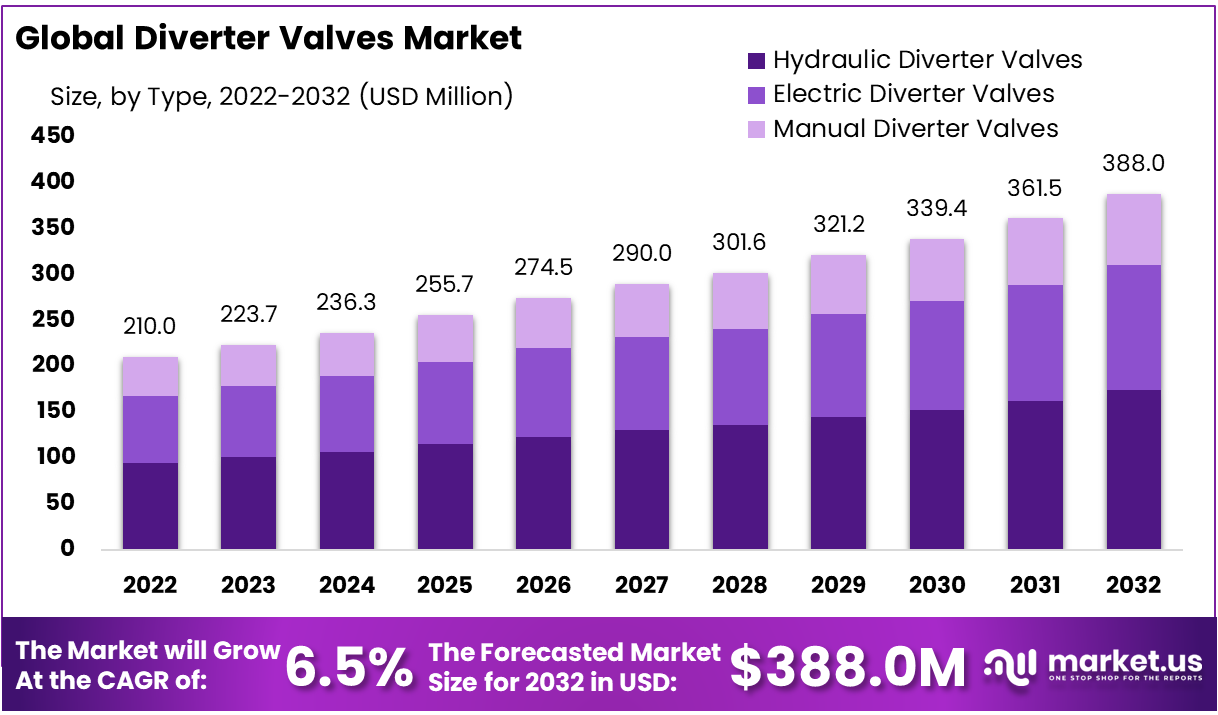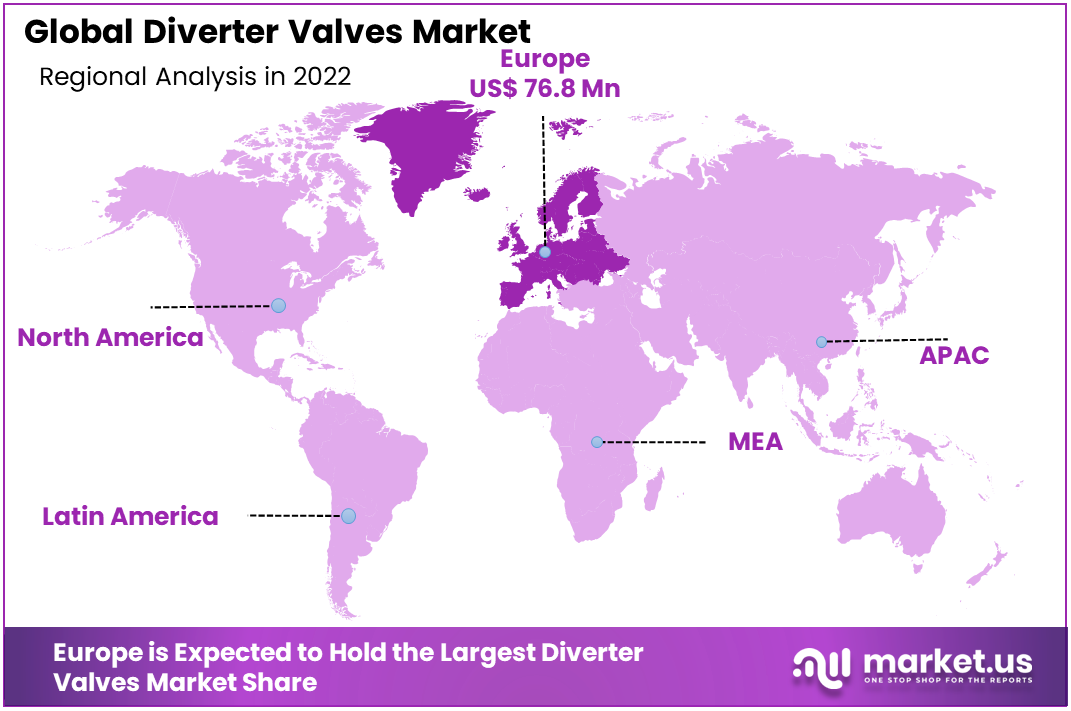Global Diverter Valves Market Size, Trades, COVID-19 Impact & Growth By Type (Hydraulic Diverter Valves, Electric Diverter Valves, and Manual Diverter Valves), By Operation (Blow-Through Diverter Valves, and Fall-Through Diverter Valves), By Material (Cast Iron, Stainless Steel, Brass/Bronze, Acetal, and Ductile Iron), By End-User Industry (Oil & Gas, Chemical & Petrochemical, Pharmaceuticals, Food & Beverage, and Other End-User Industries), By Region and Companies - Industry Segment Outlook, Market Assessment, Competition Scenario, Trends, and Forecast 2023-2032
- Published date: Sep 2023
- Report ID: 27534
- Number of Pages: 247
- Format:
- keyboard_arrow_up
Quick Navigation
Report Overview
The Global Diverter Valves Market size is expected to be worth around USD 388.0 Million by 2032 from USD 210 Million in 2022, growing at a CAGR of 6.50% during the forecast period from 2023 to 2032.
A diverter valve is a fundamental component in various mechanical and industrial systems and plays a pivotal role in controlling the flow of liquids, gases, or other substances. This valve is designed to redirect the flow from a single input stream into two or more separate output paths, allowing for efficient and precise regulation of the distribution of materials within a system.
Diverter valves find applications across a wide range of industries, including manufacturing, oil and gas, water treatment, food processing, and more. Their ability to manage fluid flow direction with accuracy and reliability makes them indispensable for optimizing processes, enhancing safety, and maintaining the integrity of complex systems.

Actual Numbers Might Vary in the Final Report
Driving Factors
Growing Demand for Water Conservation and Rising Use in Commercial & Industrial Applications
The global population is on the rise, and the availability of water resources is becoming more limited. This has led to a rising demand for water-efficient products, including diverter valves. Diverter valves play a crucial role in water conservation by effectively managing water flow to different areas. For instance, they can be employed to regulate water distribution in sprinkler systems, ensuring that only specific areas receive water.
Diverter valves find applications across various sectors like commercial, industrial, and agricultural settings. They are integral components in HVAC systems, irrigation setups, and food processing plants. The growing adoption of diverter valves in these sectors is propelling the expansion of the diverter valve market. In HVAC systems, for instance, these valves control airflow to distinct rooms, thus enhancing energy efficiency and curbing operational costs.
Government Regulations Promoting the Use of Water-Efficient Products
In recent times, considerable strides have occurred in the design and fabrication of diverter valves. These progressions have resulted in heightened effectiveness, dependability, and cost-effectiveness of diverter valves. As a result, the appeal for diverter valves has surged.
A case in point is the emergence of novel materials and production methodologies that enable the creation of diverter valves boasting enhanced durability and reduced susceptibility to leaks. Consequently, this surge in durability has been instrumental in propelling the demand for diverter valves in Europe.
Restraining Factors
High Initial Investment and Maintenance Challenges Have Negative Impact on Market Growth
The initial setup cost for diverter valves is relatively high. For many industries, especially small and medium enterprises, affording such a substantial investment becomes a significant restraint. While these valves promise long-term efficiency, the upfront costs can deter potential buyers.
Diverter valves, especially those used in rigorous industrial settings, require regular maintenance. Inadequate upkeep can lead to operational failures. The associated maintenance costs and the necessity of periodic shutdowns for servicing can restrain market growth.
Growth Opportunities
Increasing Industrial Automation and Expanding Construction Sector Expected to Create Lucrative Growth opportunities in the Global Market
The increased automation in various industries is one of the driving forces behind the growing demand for diverter valves. Automation requires precise control over flow paths, making the use of such valves indispensable. From food processing to pharmaceuticals, industries are relying more on automated systems, leading to more opportunities for diverter valve manufacturers.
The global construction industry, with its demand for HVAC (Heating, Ventilation, and Air Conditioning) systems, is indirectly propelling the need for diverter valves. These valves help in directing the flow of air or water, making HVAC systems more efficient. As urbanization increases, the construction of new buildings and infrastructures will likely see more use of these valves.
Emerging markets, such as those in Asia and Africa, are witnessing rapid industrialization. This growth translates to an increased demand for machinery and equipment, including diverter valves. As these economies continue to expand, the diverter valves market will likely see further growth opportunities.
Latest Trends
Demand for Diverter Valves is Increasing in the Food Processing Industry
The global diverter valve market has seen a substantial uptick in demand within the food processing industry. These valves play a crucial role in directing the flow of food ingredients, ensuring the smooth operation of production lines. Manufacturers are consistently improving their designs for hygiene and efficiency. Manufacturers are increasingly turning to durable materials to ensure long-lasting performance in harsh conditions.
The use of corrosion-resistant alloys and advanced plastics has become commonplace. This not only enhances the lifespan of the valves but also boosts their reliability. Digital transformation is impacting the valve industry as well. Many companies now offer smart diverter valves, equipped with sensors and integrated with IoT technologies. This allows real-time monitoring and remote control, enhancing efficiency and reducing operational costs.
Type Analysis
The Hydraulic Diverter Valves Segment is Dominant in the Market, with the Largest Market Share
Based on segmentation, the global diverter valves market comprises hydraulic diverter valves, electric diverter valves, and manual diverter valves. In 2022, the hydraulic diverter valves category held the market’s largest share at 45% and is projected to maintain this dominance throughout the forecast period. These valves operate through hydraulic pressure and find utility in applications necessitating high flow rates or pressures.
Their prevalence in diverse industrial applications, including piping systems, process control, and HVAC systems, fuels the segment’s growth. The electric diverter valve segment is anticipated to exhibit the swiftest Compound Annual Growth Rate (CAGR) in the forecast timeframe. This projection is underpinned by escalating demands for automation and the precise regulation of flow. Electric valves are actuated via electrical signals and are tailored for situations demanding meticulous control over liquid or gas flow.
Operation Analysis
Blow-Through Diverter Valves Segment is Dominant in the Market
The global diverter valves market is segmented into blow-through diverter valves and fall-through diverter valves, based on their operation. The blow-through diverter valves segment held the majority market share of 65% in 2022. These valves are designed to enable the uninterrupted flow of materials through the valve body. They are particularly useful in scenarios where preventing material backflow is essential. Their widespread application across industries like oil and gas, water and wastewater treatment, chemicals, and food and beverages is propelling their growth.
Meanwhile, the fall-through diverter valves segment is projected to experience the fastest growth during the forecast period, primarily driven by heightened demand from the oil and gas sector. While less common than blow-through diverter valves, fall-through diverter valves are gaining popularity due to their capacity to handle high flow rates and pressures.
Material Analysis
The Cast Iron Diverter Valves Segment is dominant in the Market
The global diverter valves market is categorized into several materials including cast iron, stainless steel, brass/bronze, acetal, and ductile iron. Notably, the cast iron diverter valves segment held a substantial market share of 35% in 2022. Cast iron is recognized for its robustness and longevity, displaying notable resistance against corrosion and water.
Furthermore, it presents a budget-friendly choice, rendering it economically viable for various applications. These cast iron diverter valves find utility across sectors such as water wastewater treatment, chemicals, and food and beverages. Meanwhile, the stainless steel diverter valve sector anticipates the swiftest growth during the projected period. This projection is attributed to stainless steel’s exceptional resistance to corrosion and its durable nature.
End-User Industry Analysis
The Oil & Gas Industry Led the Diverter Valves Market with a Dominant 30% Share in 2022
Based on the end-user industry, the global diverter valves market comprises oil & gas, chemical & petrochemical, pharmaceuticals, food & beverage, and other sectors. Notably, the oil & gas segment claimed a significant market share of 30% in 2022, retaining its dominance through the forecast period. This segment relies extensively on diverter valves for tasks like flow control and isolation.
Simultaneously, the chemical and petrochemical segment is poised to exhibit the swiftest Compound Annual Growth Rate (CAGR) during the forecast period. Diverter valves find versatile utility here, encompassing functions such as flow control, pressure regulation, and isolation.

Global Diverter Valves Market Segments Includes:
By Type
- Hydraulic Diverter Valves
- Electric Diverter Valves
- Manual Diverter Valves
By Operation
- Blow-Through Diverter Valves
- Fall-Through Diverter Valves
By Material
- Cast Iron
- Stainless Steel
- Brass/Bronze
- Acetal
- Ductile Iron
End-User Industry
- Oil & Gas
- Chemical & Petrochemical
- Pharmaceuticals
- Food & Beverage
- Other End-User Industries
Regional Analysis
Europe Dominates the Global Diverters Valves Market Propelled by Demand in the Commercial and Industrial Sector
Europe dominated the global diverter valves market with a market share of 36.6%, followed by North America. Europe accounts for the majority share in the global diverter valve market, followed by North America. The growth of this market is driven by the increasing demand for these valves in the automotive, marine, as well as food and beverage industries.
The growing demand for automation in these industries is also propelling the growth of this target market. In addition, the growing adoption of diverter valves in the construction sector is also contributing to the growth of the market.

Key Regions and Countries Covered in this Report:
- North America
- The US
- Canada
- Europe
- Germany
- France
- The UK
- Italy
- Spain
- Russia & CIS
- Rest of Europe
- APAC
- China
- Japan
- South Korea
- India
- ASIAN
- Rest of APAC
- Latin America
- Brazil
- Mexico
- Rest of Latin America
- Middle East & Africa
- GCC
- South Africa
- United Arab Emirates
- Rest of the Middle East & Africa
The key players in the global diverter valves market are focusing on product innovation, mergers and acquisitions, and expansion to new markets to maintain their competitive edge in the market. Several players in the market are constantly developing new products and technologies to meet the changing needs of the market.
Some major key players are also expanding their geographical reach to tap into new growth opportunities. In addition, they are focusing on partnerships and collaborations to strengthen their position in the market.
Market Key Players:
- Emerson Electric Co.
- Flowserve Corporation
- Weir Group PLC
- Cameron International Corporation
- Rotork plc
- GEA Group AG
- Pentair plc
- Mueller Water Products, Inc.
- IMI plc
- ITT Inc.
- Alfa Laval AB
- Spirax-Sarco Engineering plc
- Other Key Players
Recent Developments:
- In January 2023, Emerson Electric Co. revealed its acquisition of Rotork plc, a British multinational engineering company known for its expertise in valves and actuators. This strategic move is aimed at enhancing Emerson’s presence in the diverter valve market.
- In June 2023, Pentair plc introduced a new series of diverter valves tailored for the water and wastewater treatment sector. These valves are meticulously designed to cater to the specific requirements of the water and wastewater treatment industry, focusing on attributes like corrosion resistance and minimized maintenance needs.
- In October 2023, Alfa Laval AB made an announcement about its acquisition of WL Controls Pvt. Ltd., an Indian firm renowned for manufacturing diverter valves. This acquisition is anticipated to bolster Alfa Laval’s position within the Indian market.
Report Scope:
Report Features Description Market Value (2022) US$ 210.0 Mn Forecast Revenue (2032) US$ 388.0 Mn CAGR (2023-2032) 6.5% Base Year for Estimation 2022 Historic Period 2016-2022 Forecast Period 2023-2032 Report Coverage Revenue Forecast, Market Dynamics, COVID-19 Impact, Competitive Landscape, Recent Developments Segments Covered By Type: Hydraulic Diverter Valves, Electric Diverter Valves, and Manual Diverter Valves; By Operation: Blow-Through Diverter Valves and Fall-Through Diverter Valves; By Material: Cast Iron, Stainless Steel, Brass/Bronze, Acetal, and Ductile Iron; By End-User Industry: Oil & Gas, Chemical & Petrochemical, Pharmaceuticals, Food & Beverage, and Other End-User Industries Regional Analysis North America: The US and Canada; Europe: Germany, France, The UK, Italy, Spain, Russia & CIS, and the Rest of Europe; APAC: China, Japan, South Korea, India, ASEAN, and the Rest of APAC; Latin America: Brazil, Mexico, and Rest of Latin America; Middle East & Africa: GCC, South Africa, United Arab Emirates, and Rest of Middle East & Africa. Competitive Landscape Emerson Electric Co., Flowserve Corporation, Weir Group PLC, Cameron International Corporation, Rotork plc, GEA Group AG, Pentair plc, Mueller Water Products, Inc., IMI plc, ITT Inc., Alfa Laval AB, Spirax-Sarco Engineering plc, and Other Key Players. Customization Scope Customization for segments, region/country-level will be provided. Moreover, additional customization can be done based on the requirements. Purchase Options We have three licenses to opt for: Single User License, Multi-User license (Up to 5 Users), Corporate Use License (Unlimited User and Printable PDF) Frequently Asked Questions (FAQ)
What is the Diverter Valves Market Size in the Year 2022?The Global Diverter Valves Market size was USD 210 Million in 2022, and is growing at a CAGR of 6.50% during the forecast period.
What is the Diverter Valves Market CAGR During the Forecast Period 2023-2032?The Global Diverter Valves Market size is growing at a CAGR of 6.50% during the forecast period from 2023 to 2032.
What is the Diverter Valves Market Size Estimated During the Forecast Period 2023-2032?The Global Diverter Valves Market size is expected to be worth around USD 388.0 Million during the forecast period by 2032.

- Emerson Electric Co. Company Profile
- Flowserve Corporation
- Weir Group PLC
- Cameron International Corporation
- Rotork plc
- GEA Group AG
- Pentair plc
- Mueller Water Products, Inc.
- IMI plc
- ITT Inc.
- Alfa Laval AB
- Spirax-Sarco Engineering plc
- Other Key Players
- settingsSettings
Our Clients
| Single User $4,599 $3,499 USD / per unit save 24% | Multi User $5,999 $4,299 USD / per unit save 28% | Corporate User $7,299 $4,999 USD / per unit save 32% | |
|---|---|---|---|
| e-Access | |||
| Report Library Access | |||
| Data Set (Excel) | |||
| Company Profile Library Access | |||
| Interactive Dashboard | |||
| Free Custumization | No | up to 10 hrs work | up to 30 hrs work |
| Accessibility | 1 User | 2-5 User | Unlimited |
| Analyst Support | up to 20 hrs | up to 40 hrs | up to 50 hrs |
| Benefit | Up to 20% off on next purchase | Up to 25% off on next purchase | Up to 30% off on next purchase |
| Buy Now ($ 3,499) | Buy Now ($ 4,299) | Buy Now ($ 4,999) |












